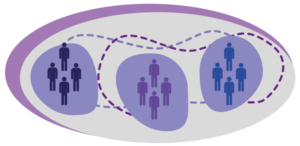
What is market segmentation? Definition, criteria and examples
- 23 Februar 2021
Customers who buy products online display different types of buying behaviors. They are the result of a combination of different factors – income, age, sex, habits, interests and needs. Because of such a large diversity, it is almost impossible to prepare an offering that would be attractive to all customers. And this is where market segmentation can be really useful. What is market segmentation and why is it necessary for e-commerce sales?
Market segmentation – what is it?
Market segmentation is a process of dividing customers into groups with common characteristics and behaviors. This way, you can learn more about the needs of the buyers and adapt your offering to better meet your customers‘ expectations.
Market segmentation is an important tool in both B2B and B2C sales. It ensures not only greater customer satisfaction but also tangible business results. For example, thanks to market segmentation, we can identify those groups of buyers that bring us the biggest profit and then intensify our marketing activities for those specific segments. Market segmentation thus allows us to plan a more effective business strategy and optimize budget management.
Market segmentation criteria
We can segregate customers on the basis of standard geographic, economic, demographic and social criteria, such as:
- sex
- age
- marital status
- education
- income and source of income
- nationality
- place of residence
- lifestyle and interests.
However, currently, it is becoming increasingly important to know the online behaviors of the customers. This is precisely the thing that tells us the most about the habits and preferences of the buyers. That is why the market segmentation process increasingly often includes such data as the number and type of visited websites, products and services chosen most often, the frequency and place of shopping and the average value of the shopping basket or favorite brands. Gathering such information allows e-commerce sellers to better adapt their offering to specific groups of customers.
The advantage of e-commerce sales is that you can carry out market segmentation surprisingly easily with the use of modern tools. After the installation of special tags, we can systematically gather data about our customers. Then, we can use systems for segmentation that have the scoring option, which allows us to assign values to certain types of behaviors and then automatically send personalized marketing e-mails, advertisements and offers to the relevant groups of customers.
Customer segmentation – why is it worth it?
Defining your ideal customer profile or profiles is crucial in e-commerce sales. Effective market segmentation allows you to:
- better adapt the offering and the prices to your customers,
- design personalized communication and more targeted messages for each of the segments,
- improve the quality of customer service,
- choose your most profitable groups of customers and accordingly adapt your business strategy,
- quickly respond to the changing needs and expectations and situation on the market,
- choose better and more profitable promotion and communication channels.
It is also important that both the seller and the customer benefit from segmentation. Thanks to the collected data, the seller can carry out more accurate marketing and selling activities, and the customer is more satisfied with the purchased goods and services. This increases the number of conversions and loyal buyers.
Customer segmentation and prices
Correct segmentation also allows you to better adjust your pricing strategy. If you know who your customers are and what they need, it is easier to accordingly adjust your promotions and advertisements and build the right price structure of the offering. You can also better monitor and track the actions of our competition in selected segments.
Information on competition and their prices is available, for instance, in the reports of the Dealavo tool, in the “retailers” section. This way, you can see which of the products you offer are also sold by the competition and what percentage of the offering is the same. You can also check if products offered by both you and your competition are characteristic for a particular customer segment. The monitoring of the way in which the competition targets particular groups, especially when combined with automatic price setting (dynamic pricing), allows you to respond faster to market changes and achieve better sales results and margins, without any additional effort.
Market segmentation – examples
A typical example of segmentation is the division into economy and premium customers. After you distinguish between those two groups, you can display suitable discounts, promotions and advertising creations that highlight the value of the offering for each group. We can also determine what products are most often selected by the customers who seek the lowest prices and then use a strategy that will guarantee the products to be in the TOP 3 cheapest options on price comparison websites.
Of course, after conducting customer segmentation, we can also display advertisements dedicated to particular age groups or people with specific buying behaviors and interests. As the next step, you can also offer products that are complementary to those the customer already has (for example, displaying the advertisement of a sports outfit to persons who have recently bought a bicycle). To do this, you can use various marketing tools, such as newsletters, banners, notifications, pop-ups or remarketing.
Contact us if you would like to get more information on customer segmentation. We will tell you, how to automate prices in your online shop and adjust your pricing strategy to particular segments in order to maximize profit from online sales.